This page provides some general but essential instructions and tips for those who are looking for an answer on question how to start mountain climbing. I myself started mountaineering almost 4 decades ago by climbing Triglav (2864 m) in what is now Slovenia, so I feel I could say something about this activity.
[Jean Baptiste Lully (1632-1687) – Marche pour la cérémonie des Turcs]
Here is a screenshot from a Facebook group, I could not believe my eyes when I saw this. In short, a person without any experience in mountaineering is asking about climbing Mt Everest.
Without any intent to be judgmental, here just to stress that if you are such a type of beginner, then you will be wasting your time in this post. The text here is not for you.

About terminology
Within this site, I shall sometimes use the terms mountaineering and climbing interchangeably. This may not always be completely appropriate, and it is good to explain the meaning of these terms.
By mountaineering, I shall mainly imply an activity which requires neither alpinist knowledge nor equipment, but it may imply getting to summits by (sometimes physically very hard) walk-up and normally without scramble.
You then realize that even going to the top of Kilimanjaro (5895 m) can easily be described as mountaineering, although this is a several-day hard tour and not a leisurely walk as the word mountaineering might suggest.
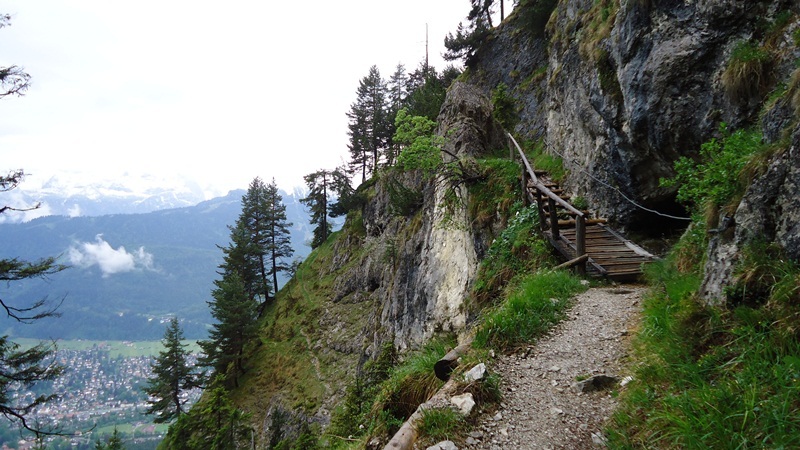
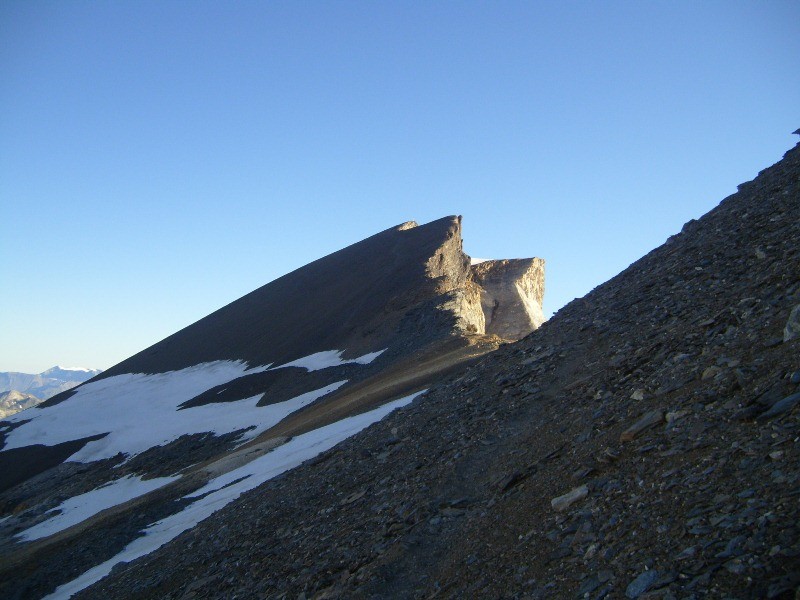
There are also many very high mountains in the Alps where one can go in such a way. I would point out several peaks around Stelvio pass like Monte Scorluzzo (3095 m), Piz Umbrail (3033 m), and Punta Rosa (3026 m). Then Monte Breva (3104 m) near Livigno, and also such a high mountain like Barrhorn (3610 m) in the Wallis region in Switzerland.
These are very high mountains and yet in summer time all you need from equipment is a pair of comfortable hard walking shoes. Buying such shoes is an investment but they will last for many years. My own pair I have been using for 7 years now and they are far from worn out.
But do not underestimate challenges in front of you, and be prepared for unstable weather conditions even if you have a completely clear sky before you set off.
The word climbing should be understood as activity which involves scramble (using hands to get over obstacles and steep rock walls), or specific equipment (like crampons, an ice axe, a rope, and many others), or enjoying challenges which some Ferrata-routes (this is an Italian phrase for routes with fixed iron cables and other equipment which is already installed there in the rock itself; Eisen-weg in German and Austrian mountains).
But I shall use both terms or just the term mountain climbing to distinguish this activity from rock climbing which is no part of this site in any sense. In any case, the actual meaning of terms will always be obvious in the descriptions of every specific mountain.
So how to start mountain climbing?
For whom is this activity?
This is for anyone, mountains have something to offer for everybody, regardless of age, regardless if you go alone or in a group, with a guide or without. I climbed Durmitor in Montenegro with my two daughters when they were 9 and 11, and we managed it, the photo below describes the full beauty of that experience.
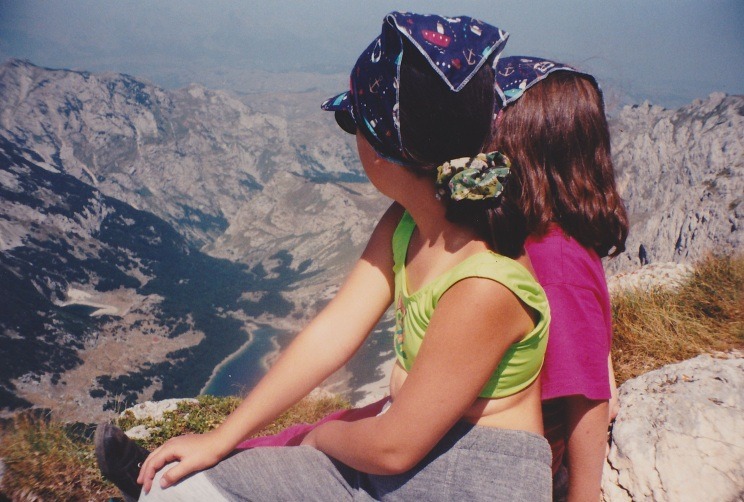
Recently, I was in Italian mountains with my friend M. Kono who was 70, and who has never tried mountain climbing before, a university professor with normal fitness for such an age and profession. We stayed only one week and yet we were four times above 3000 meters. It was an impressive performance.
If you dream about mountains and have never tried it, the best way to start is just to go there once, see the environment, feel the altitude, try some easy walks up, sweat a bit and get tired, and later decide if it is for you or not. If you start asking yourself why you are doing such a terribly demanding physical activity, and you feel no joy, then perhaps indeed this is not for you.
But it may happen that, delighted with everything around, you start asking yourself: how have I missed this before? Then I know, you will come again. No doubt, at one moment, you will say to yourself: never again without this.
These pages contain material essential for those who decide to go and do some mountain climbing. They contain information about:
- where to stay once you are in mountains,
- how to choose an appropriate destination,
- when to go,
- how to go,
- what kind of equipment to have,
and all this from my own first-hand experience. I wish to stress again that every photo you see in this site is my own, I have never borrowed anything from the Internet. All that you see here about mountains are places which I passed myself.
If you are a complete beginner and have neither experience nor equipment, as I said above, go there and try, but do not make big expenses in the beginning.
The focus of this page is on the Alps because this is my main area, but many facts presented here are applicable to many other mountain ranges as well. Of course, you will need some base to stay in mountains for a while, and this leads us to the first item in the list above.
Where to stay?
In the summer time, it may be a good idea, at least as a start, to think about some ski resorts because prices may be far lower than in winter. Access roads in the Alps are usually good if you go by car, and such places are also well integrated into public transport.
There are some very reliable agencies, see a separate post in this site, which I have used myself many times. They offer a large variety of flats and studios throughout the Alps. Most importantly, what you see on their pictures is indeed what you may expect. Such flats are fully equipped, and all you need is to bring your food and to feel at home.
Within this site, some ideas about the accommodation in mountains will be pointed out for every suggested climb.
How to choose an appropriate destination?
I would not say that this is an essential issue. If you like mountains you will enjoy them regardless where you go. But to be practical, if you go, you would like to achieve something and to get to some summit, so see the following hints.
There are routes to very high summits like Barrhorn (3610 m, see the photo above) in Switzerland that are, although physically demanding, much simpler than some routes to 2000 meters in Slovenia or Austria. But here are a few facts to bear in mind.
Typically, in Slovenian and German Alps, starting points are low. By car, usually, you do not get high in mountains there. For example, the only relatively high mountain pass in Slovenia is Mangart saddle (2055 m) with a car access. From this point, you can climb Mangart in less than 2 hours.
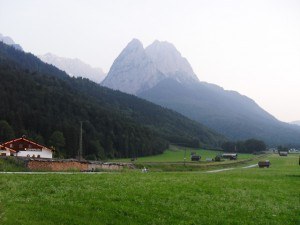
But this is not always so. Usually, you will start from a low valley at around 500-800 meters of altitude, so climbing a 2000 or 2500 meters peak is far from easy, the height difference is for every respect. Say you go to Zugspitze (2962 m) which, as many of you surely now, is the highest point in Germany. As one option you will have to start in Hammersbach, which is at around 750 meters above the sea level.
Trust me, this is demanding even if you are not a purist and use a benefit of the cable car on your way back. I did this tour, started at 3:30 in the morning and got to the summit around noon. It is a hard and demanding Ferrata.
Now compare this for example with Gavia pass in Italy with a comfortable car access to 2650 m! From this point, you can climb Monte Gaviola (3025 m) in one hour only.
What have we learned from this? If you are in high mountains and have no much time (bad weather for example) or lack of stamina, use the advantage of mountain roads and high passes.
I agree, this is a bit of cheating, but if you want to read about starting directly from valleys, see some of my other texts within this site, like Weissmies or Lagginhorn. These are 4000ers, and I climbed them directly from the valleys. No cheating.
When to go?
This IS an important issue. If you dream about `green mountains’ like I do, then this is surely summer time, roughly the period June – September for the Alps. The weather is typically more stable in the second half of the season, but do not rely too much on this. The truth is, it is unpredictable.
There is a lot of snow in the Alps in the early season, in particular if you go above 3000 meters. Bear this in mind if you go in June. In this case, you might like to think about going into majestic Slovenian Alps. They are lower compared to Austrian or Swiss mountains, but in most cases very sharp and equally exciting. You will like them, no doubt about this.
On the other hand, typically, north sides of mountains are under snow much longer than south sides, so bear this in mind when you plan your mountaineering routes. In early season better think about south-sides routes.
One of the best examples of such a drastic south-north difference is Weismiess (4023 m) mountain in Wallis, Switzerland. The north side looks like a Himalayan environment, covered with dangerous glacier full of crevasses where a solo climb is definitely risky (but people do it). The south side however in the summer time is snow-free all the way up to around 3900 m, compare the two pictures below which I took during my climbs there.
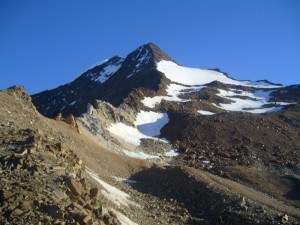

How to go?
If you go to the Alps in the summer time, it is good to know that these mountains are full of people, there are good access roads everywhere to real hearts of the mountains. Having a car is an obvious advantage. Sometimes you will like to climb some peaks from nearby valleys, and this may imply starting in early hours, so having a car in such situations is essential.
However, in Switzerland public transport is good, and famous Post Buses go practically everywhere. As one nice illustration, I would mention a bus line from Grimentz to the Moiry lake area. It will take you up to 2350 m, to the point (see the links next line) from where you may climb many surrounding peaks, like Pigne de la Le, Garde de Bordon, and Sasseneire.
What kind of equipment to have?
To start mountain climbing, I would advise against any huge investment. In time, the amount of equipment will grow just like your experience and desire to go to mountains. But as a start, think only about a pair of good walking shoes, some waterproof jacket and pants, and a backpack for day tours.
In the descriptions of various peaks, I shall always try to say something about essential gear. But if you wish to have a look into possible equipment and to get some idea about prices, you might search within this equipment reviews page in this site.
I hope that within this page you have found essential information and answers to the question on how to start mountain climbing. If you have any doubts and questions, please do not hesitate to contact me.
Please leave your comment and questions below, I shall be happy to read them. Any suggestion for the improvement of this page and the site is most welcome.
harris cahyo kartiko says
terimakasih untuk semua yang anda tuliskan. sangat membantu bagi saya terutama ulasan tentang alat alat yang digunakan untuk naik gunung dan berkemah
saya ucapkan terimakasih dan sehat selalu
Jovo says
You are most welcome, and thank you for the lind words.
KADYFA says
Thank you for starting climbing the mountains. I would like to try Mt Rwenzori (Mountain of the moon). It is very interesting
Jovo says
Most welcome. I can imagine, I would like to go there too.
Jeffery Fernandez says
I just returned from Mt. Kilimanjaro. It was my first, and probably my last high altitude mountaineering trip. Watching the sunrise from the top of the mountain was great. However, the experience was offset by the five days of relatively short hikes at a frustratingly slow pace that it took to get there. If you want the bragging rights of getting to the top, or if you think the effort required to get to the top will be a life-changing challenge, by all means, climb Kili. On the other hand, if you are fit and used to long miles with lots of climbing, you may want to consider a different trek at lower altitudes where you can do longer miles at a faster pace.
Jovo says
Hi Jeffry, so great to hear about your adventure. Kili has always been my dream. But I have heard from people who have climbed it that it must be in organized tours and they carry your stuff and prepare meals and set the tent, so I know I shall never be there. This is not how I imagine mountaineering. Going to the mountains is a personal thing for me. I would pay that they let me do it on my own, solo, this is the only way for me, but I guess this will never happen and it will remain my dream. Meanwhile, I shall do my climbs in the Alps. Thank you again, all the best.
John Oyech Lwong says
Hi, Thanks you for the insight I really enjoy read it. My question is “does it pay to start a mountain climbing business? say a club or a company and how can one go about?
Am living in South Sudan and there are alot of unexplored mountains here, how can one start going up there where no one had ever been there?
Jovo says
Hi John. I started more than 30 years ago and did not think about this as a business, the same holds to this day. I go to mountains to feel alive. From what you write, this sounds like a paradise for mountaineers and climbers, but making a business from this depends on the social environment and culture. If people do not go to such places the chances may be slim to make a business of it. But if this is for your own pleasure, just go if it is safe enough.
Gareth says
This is a great read and very informative! I’m very new to this and to start with I’m going to build up my fitness on indoor climbing walls etc. And some local uk climbing. When I do decide to climb a mountain do I go in a group? Do I need a guide? And how would I go about this? And also how do you get used to altitude? Many thanks
Jovo says
Thank you Gareth. It is best that you join a group if available. You will feel safer and it may be more pleasant. Though I must admit that I mostly go solo. This makes me independent of anybody, but this is not the smartest way, this is a fact.
As for a guide, this will depend on where you go, guides are expensive in general. I myself have never had a guide. How to find one? If you go to any of the big centers like Zermatt, just ask in any information office, they will direct you. If this is about a popular mountain like Breithorn, they form a group and those can be big sometimes, in such cases the group depends on the weakest person in the group so it can be annoying. For more serious climbs it is one to one or two maximum, so it is far more expensive and you have to follow the tempo of the guide in order to finish the climb in time, so it may be tough.
As for the altitude sickness, this is very individual and there is no way to predict it. I climbed Teide 6 times and only during the 6th tour I hardly managed due to very strong symptoms. Acclimatization is the only way to cope with it. How much time, hard to say. It is best to try and see how the body reacts.
Ania says
Wow, very, very useful. Thank you. I am only starting my adventure with mountaineering as I am going to climb up the Snowdon in May. Once again, thank you for such a useful information.
Jovo says
Many thanks Ania, you are so kind to me. Please have a look around in you need any other info regarding hiking and mountaineering tours and equipment, and let me know if you need any help.
Karolina P says
I love your page. We have only started our climbing adventure. So far the highest pion was Snowdon woth two children( 6 and 8). This year we are planning to go up Ben Nevis with children. We usually check the route before we take children but they are loving it and never gave up. I will keep reading . Very usefull.
Jovo says
Thank you Karolina. Your message brings back my own memories with children at that age. I keep the picture of my daughters on the home page in the site just because of such memories, this was almost two decades ago, and I am not going to remove it anytime soon. So it was long ago but I can understand you well. Let them carry at least something of their stuff in their own backpacks, they will feel like real mountaineers.
Have seen such a family with two small kids on my route to Sasseneire, the mountain looks sharp and difficult but in fact the ridge route described in my text is just a walk. So if you go to the Alps, that is one of the options. Good luck, and if you have time why not sending me some texts with photos from your tours with kids, I shall be happy to add it to the site. There is an open invitation for guest authors.
chucho says
Great site Jovo!
Have you been to the Polish or Slovakian Tatras? I spent all of July there and I loved it. I’m looking forward to going back next year and climb Rysy, which I didn’t have time to climb this year.
Jovo says
Thank you chucho, kind words indeed. No, I have not been there yet. I shall bear Rysy in mind if I get into the area. Many thanks. You can write a text if you wish and I shall add it with you as a guest editor here, with your photo. It must be first-hand information and original, this is my own rule imposed on myself, I write only about routes I passed myself.
sebastian says
The first mountain i climbed was the Iztaccihatl in Mexico, 5230m, it kicked my ass.
Jovo says
This is a completely different environment from what I have in the Alps. The start of your route was probably at around 4000 meters so the actual difference is not big, but I can imagine the altitude effects. So you started at the altitude with only 63% of Oxygen and climbed to the level where it is 50% of the normal value.
Have not been there, hopefully someday. I envy you.
Simon Williamson says
Wow! Your site is great!
admin says
Thank you Simon, I really hope so. All the best to you.
Henry says
Greetings,
Very practical yet simple approach here. Explaining the difference between climbing & mountaineering definitely helps to distinguish one from another. No guessing, it’s good to know what to expect.
So all it takes initially is to find a pair of durable hard walking shoes & desire to start mountain climbing?
You also say mountains have something to offer for everybody. Well, you got my attention – I’m extra curious, theoretically, what kind of physical shape you must have, in order to even think about doing all of that? Mountain climbing sounds quite a task!
I believe even smaller mountains can provide challenges & by doing that all year round you could end up with incredibly fit body.. or injure yourself. So, one thing is choosing our mountaineering tempo, & how often we go out there, but what about all the physical preparation? Should a beginner hit the gym first etc?
..or simply go on spot & start with an easy walk up towards peak, in order to see how far you can make it & test your limits?
Regards,
Jovo says
Hi Henry, I think you formulated the answer in the last sentence. Just go and see if you like it or not. Do not invest in anything, and do not make any preparation. Try it and you will know if it is for you or not. That is the only way. All thy best to you.
Dylan says
Hey this is a really amazing website with a lot of interesting content. Also, your design is really cool too.
This is a rally in depth guide on how to start mountain climbing, I like how you show that your daughters can do it, so if any person wants to they can. I also like the suggestions you gave for mountains to climb.
Thanks for the information
Jovo says
Thank you Dylan, great to read your comment. The photo of my daughters is my the most favorite in all the site. That was a real climb and they were so young, but we managed.
Andre says
Your pages are very inspiring.
Congratulations on a wonderful site, innovative and I like the lay-out.
A good article on mountains and specifically on how to start mountain climbing – most detailed.
Your website is very well planned and thought out.
We (us who loves mountains!) are in love with your website; it is beautiful, clean and simple.Your informative guidance, patience and responsiveness is very apparent throughout the entire website.
Job well done!
Jovo says
Thank you Andre, your comment is very inspiring as well. I write only about first-hand experience and to the point. This is what I want to see myself when I search for information about certain mountain before my climb. Thanks again.
Gary Moorey says
Hi Jovo,
I have never climbed a mountain but I have been to the top of Mount Snowdon in Wales by train and walked back down, I have also stayed at the Base of Mount Cook in a place called the Hermitage, I would just like to say your site really brings to life the advantages of getting out and exploring, Mountains to me have a magical quality , I have seen the Matterhorn close up and it really is awe inspiring and you bring this to life on your site, my Step Mother is still climbing mountains in New Zealand at the age of 65, but I have a problem getting up a step ladder these days, but your site is tremendous Jovo, I love it.
Jovo says
Many thanks Gary, it is indeed a pleasure to read your comment. I completely share your sentiment about mountains and their magic. In fact I have a text with the word magic in the title. Just a few days ago I have been in Austrian Alps and have seen people of every possible age very high in the mountains, above 3000 meters. So it does not surprise me that your step-mother is still out there at the age of 65. Thank you again.
Stu says
Nice site! I like how in depth you go in this article with explaining the ins and outs of mountain climbing. You come across as very knowledgeable on the subject, and I really liked that you included a personal photo. Some more of that kind of thing would make this page stand out more. Showing people that these hikes and treks can be done goes a long way..
Anywho, keep up the great work here, and I look forward to reading more..
-Stu
Jovo says
Hi Stu, great to read your comment. I have some more personal photos on some other pages like Monte Breva or Refuge Battaglione Ortles, or Pizzini hut. Though in majority of my climbs I go solo and there are no many faces there indeed.
kirk says
Very attractive post for me as I am most at home in the mountains. I have climbed mostly in the Adirondacks as they are where I grew up. Although I am not a “46er” I have climbed 101 peaks there. Just keep climbing the ones I like the best. Winter mountaineering was my favorite. I spent several years rock climbing and got fairly skilled at it. My favorite part is leading and learning how to place good solid pro. Did some ice climbing as well. That was some of my favorite climbing but a little scary. Have climbed some 14,000 peaks in the Rockies as well. As I am getting a bit older know I like to hike in the mountains. After reading your post, I am inspired to plan my next backpacking trip.
Thanks
Kirk
Jovo says
Hi Kirk, it is indeed a pleasure and honor for me to read your comment. I did not do ice climbing, I am sure this is not for me. I need altitude and to feel the mountain around me. As for backpacking, in the Alps there are many possibilities to do great tours at high altitude and in the same time to start from a high point due to high access by a car. Typically those are high passes like Gavia, Stelvio or Forcola pass.
Katia says
Hi Jovo,
I’m in love with your site. I’m going to Europe this Winter and I really wanted to do some hiking and mountain climbing but being a complete beginner didn’t know where to get started!
I’m also travelling on my own so this site will be invaluable to me. I’ve even bookmarked it!
Thanks for posting such useful information
All the best,
Katia
Jovo says
Hi Katia, thanks for the comment. I became worried when I read that you would go hiking and climbing in winter, but I realized you are from Australia and this is then our summer, perfect time for such activities. Let me know if you need any information. Thanks again. Jovo
Tracy says
Very useful information. Your site puts mountain climbing into more attainable goals for people like me who want to look at the whole picture.
Jovo says
Thank you Tracy, it is great you find it useful. This motivates me to work on it and to add a lot of new content. Best regards. Jovo